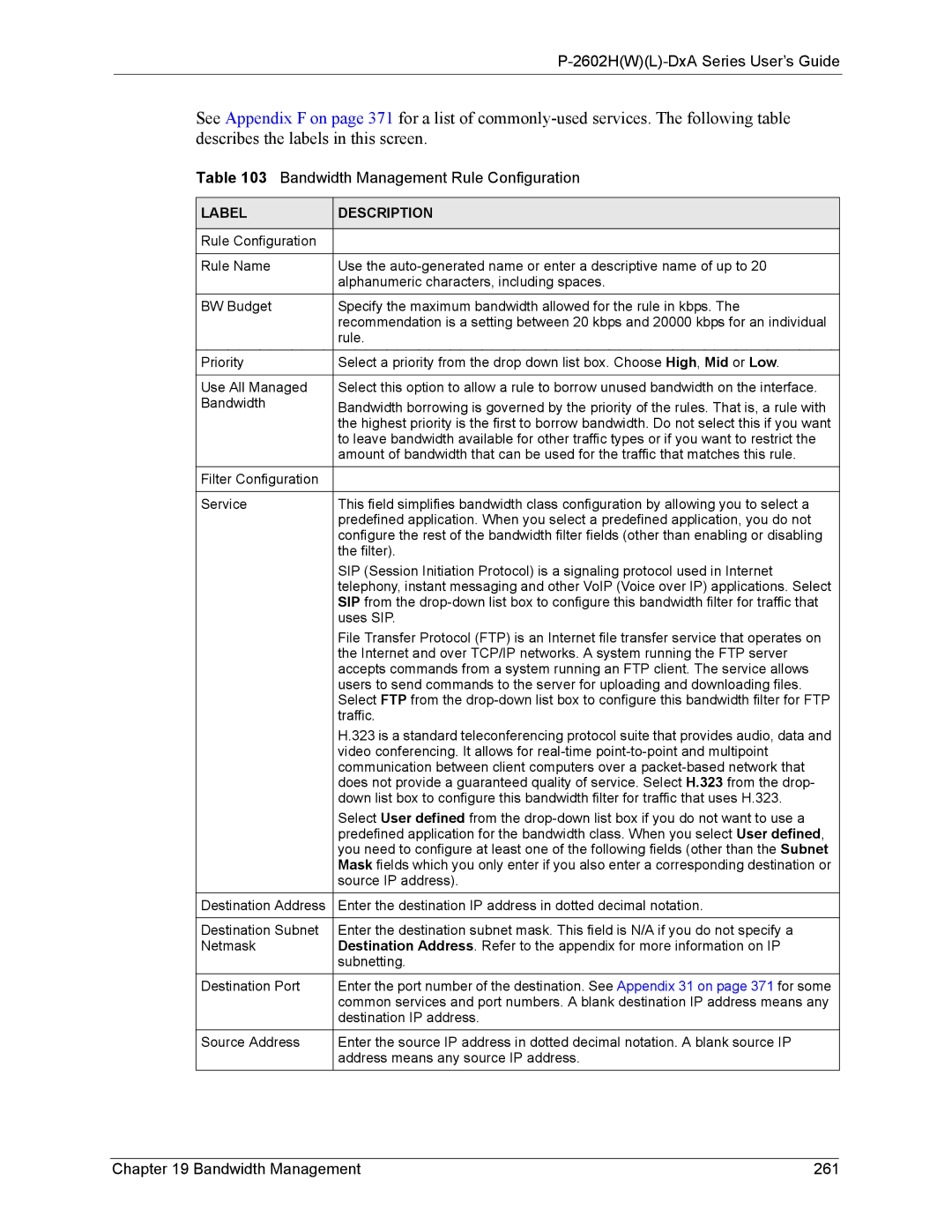P-2602H(W)(L)-DxA Series User’s Guide
See Appendix F on page 371 for a list of
Table 103 Bandwidth Management Rule Configuration
LABEL | DESCRIPTION |
|
|
Rule Configuration |
|
|
|
Rule Name | Use the |
| alphanumeric characters, including spaces. |
BW Budget | Specify the maximum bandwidth allowed for the rule in kbps. The |
| recommendation is a setting between 20 kbps and 20000 kbps for an individual |
| rule. |
Priority | Select a priority from the drop down list box. Choose High, Mid or Low. |
|
|
Use All Managed | Select this option to allow a rule to borrow unused bandwidth on the interface. |
Bandwidth | Bandwidth borrowing is governed by the priority of the rules. That is, a rule with |
| the highest priority is the first to borrow bandwidth. Do not select this if you want |
| to leave bandwidth available for other traffic types or if you want to restrict the |
| amount of bandwidth that can be used for the traffic that matches this rule. |
Filter Configuration |
|
|
|
Service | This field simplifies bandwidth class configuration by allowing you to select a |
| predefined application. When you select a predefined application, you do not |
| configure the rest of the bandwidth filter fields (other than enabling or disabling |
| the filter). |
| SIP (Session Initiation Protocol) is a signaling protocol used in Internet |
| telephony, instant messaging and other VoIP (Voice over IP) applications. Select |
| SIP from the |
| uses SIP. |
| File Transfer Protocol (FTP) is an Internet file transfer service that operates on |
| the Internet and over TCP/IP networks. A system running the FTP server |
| accepts commands from a system running an FTP client. The service allows |
| users to send commands to the server for uploading and downloading files. |
| Select FTP from the |
| traffic. |
| H.323 is a standard teleconferencing protocol suite that provides audio, data and |
| video conferencing. It allows for |
| communication between client computers over a |
| does not provide a guaranteed quality of service. Select H.323 from the drop- |
| down list box to configure this bandwidth filter for traffic that uses H.323. |
| Select User defined from the |
| predefined application for the bandwidth class. When you select User defined, |
| you need to configure at least one of the following fields (other than the Subnet |
| Mask fields which you only enter if you also enter a corresponding destination or |
| source IP address). |
Destination Address | Enter the destination IP address in dotted decimal notation. |
|
|
Destination Subnet | Enter the destination subnet mask. This field is N/A if you do not specify a |
Netmask | Destination Address. Refer to the appendix for more information on IP |
| subnetting. |
Destination Port | Enter the port number of the destination. See Appendix 31 on page 371 for some |
| common services and port numbers. A blank destination IP address means any |
| destination IP address. |
Source Address | Enter the source IP address in dotted decimal notation. A blank source IP |
| address means any source IP address. |
Chapter 19 Bandwidth Management | 261 |
